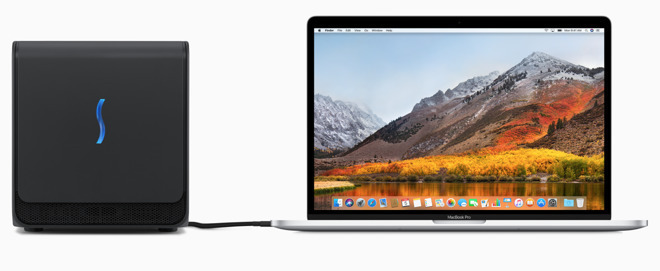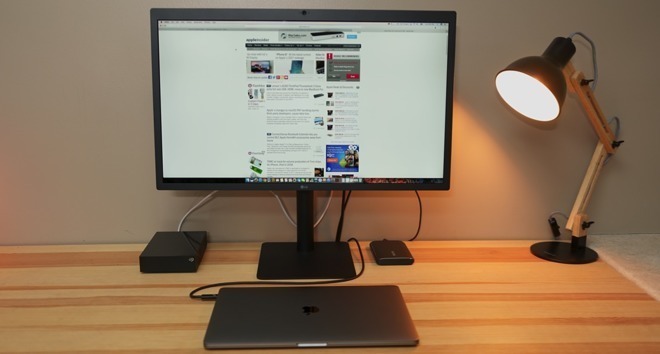In yet another likely reason that external graphics card support for Mac will not exit beta until 2018, there are not any external monitors currently on the market, compatible with macOS High Sierra's eGPU feature, that match the pixel density of Apple's own Retina displays.

Sure, there are plenty of 4K and 5K monitors on the market. But Apple's Retina display branding is not actually about resolution -- it's about how many pixels are packed into a square inch.
On the iMac, Apple has defined a Retina display as about 219 pixels per inch on the 21.5-inch 4K model, and about 218 pixels per inch with the 27-inch 5K variant.
Those same resolutions are matched by LG's UltraFine displays, available in a 4K model over USB-C, and a 5K version driven by Thunderbolt 3.

The LG UltraFine series does not accept mini DisplayPort input.
But there's a catch: Neither USB-C nor Thunderbolt 3 will currently work with Apple's eGPU feature in macOS High Sierra, which requires an external monitor. To take advantage of that, you'll need to find a monitor that allows input from mini DisplayPort, or HDMI.
That's because, with limited availability of USB-C and Thunderbolt 3 monitors, no dedicated graphics card (yet) features either port for display output. And there are no HDMI to USB-C or Thunderbolt 3 adapters (only the other way around, with hubs and cables that convert USB-C to HDMI).
Not that you'd want to run it over HDMI anyhow -- that's limited to 30 frames per second.
MSI's USB-C graphics card will add support for one Retina-caliber monitor -- when it ships.
MSI has announced a GeForce GTX 1080 Ti graphics card boasting a USB-C port. That would be compatible with LG's 21.5-inch UltraFine 4K display, but not the Thunderbolt 3 5K model. Also, it's not yet shipping.
And if you survey the landscape of mini DisplayPort and HDMI external monitors, you'll find that there aren't any consumer-focused 4K models that match the pixel density of Apple's Retina displays, nor the LG UltraFine series. Many 4K-resolution monitors are in the 23- and 24-inch range, which reduces the pixel density to under 200, falling short of Apple's Retina display standard.
If you jump up to 5K monitors, there is one non-iMac, non-LG option that is Retina-caliber: Dell's UP2715K 27-inch Ultra HD 5K monitor.
But, yet again, there is a catch: It has been discontinued. You can find it from a few resellers on Amazon, but Dell's own site no longer sells the 27-inch 5K monitor.
Developer Marc Edwards provided a roundup of Retina-caliber monitors last December and came to the same conclusion, finding only Apple's iMacs, LG's UltraFine displays, and the discontinued Dell 5K monitor as "good for Retina." Edwards went a step further and identified monitors considered in "the bad zone," offering pixel counts not at the level of a Retina display, but too far from the 110 pixel-per-inch density ideal for non-Retina displays in macOS.
Via developer Marc Edwards.
"Apple's interface design in macOS is set up so it is comfortable for most people at a density of about 110 pixels per inch for non-Retina, and about 220 pixels per inch for Retina -- text is readable and button targets are easy to hit at a normal viewing distance," Edwards wrote. "Using a display that isn't close to 110PPI or 220PPI means text and interface elements will either be too big, or too small."
It's likely that the lack of options will be addressed over the coming months. In fact, Apple itself announced in April it will be building its own external professional display in 2018, and you can be sure that the Cinema Display successor will feature a Retina display.
And given that LG's own UltraFine 5K monitor stumbled out of the gate with wireless interference, and it doesn't work properly with eGPU support in macOS High Sierra, there is a clear need on the market for alternatives.
In the interim, you won't find an alternative from Apple's own new iMacs, as the company has abandoned the niche Target Display Mode feature that allowed the all-in-one machines to serve as external displays for MacBooks.
All of this helps explain why eGPU support in macOS High Sierra won't officially launch to the public until spring 2018. Until then, users will have to test external graphics cards with limited hardware, and low-resolution displays.
